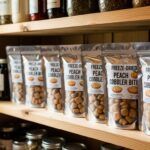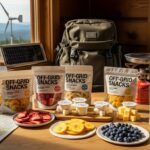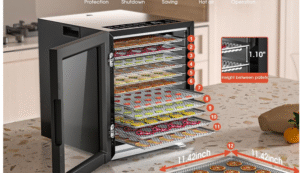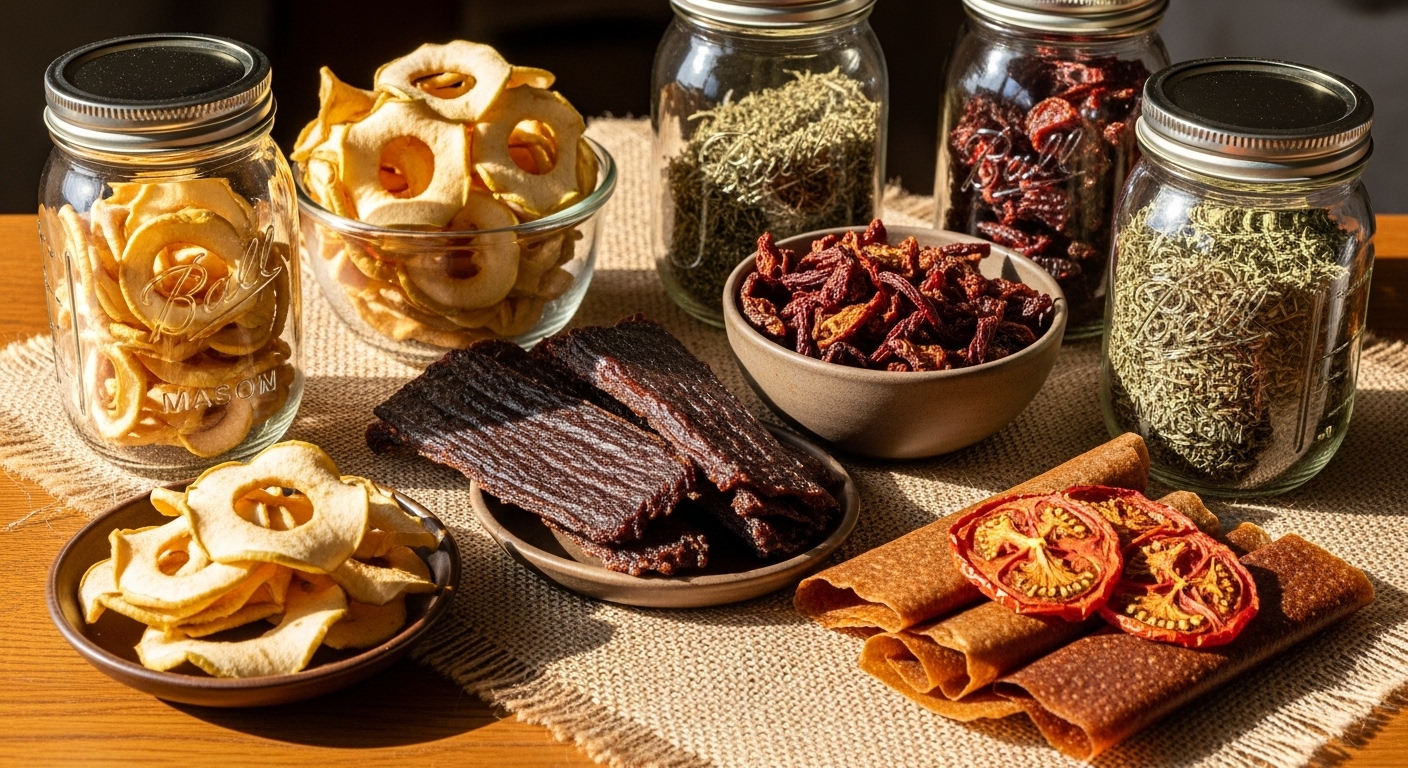Comparing freeze-dried vs dehydrated foods is something most people bump into as soon as they start with emergency preparedness food storage. If you’re figuring out what’s best for your family, your hiking pack, or bug-out bag, knowing the difference between freeze-dried and dehydrated foods can really help you make smarter choices. These food options both serve a similar purpose, but they’re not the same. I’ll break down the differences, share practical info about shelf life, nutrition, taste, and storage, and go over how each type fits long-term food preservation and survival food comparison needs.

Understanding Freeze-Dried vs Dehydrated Foods
Both freeze-dried and dehydrated foods basically reduce water content, making food stable for storage, but the process and final results have some real differences. Freeze-drying gets rid of moisture by freezing food and then removing the ice as vapor using a process called sublimation. Dehydration uses heat and airflow to dry out food over time. Each method affects taste, texture, nutrition, shelf life, and cost. Knowing these differences helps you pick the best foods for prepping based on how you want to use them. For example, home storage, hiking, or emergency kits all have different requirements.
How Freeze-Dried Foods Are Made
Freeze-dried foods start their adventure by being quickly frozen, then placed in a vacuum chamber. Here, the frozen water in the food skips the liquid stage and turns directly into vapor. What you get is a light, dry chunk that keeps its shape better than most dehydrated snacks. Freeze-dried meals are super lightweight, which makes them really popular as lightweight backpacking meals and for emergency survival rations. This process locks in flavors and nutrients, leading to a higher-quality product for long-term food preservation. That light texture also makes freeze-dried foods easier to portion and pack, which means less waste and more flexibility for meal planning.
How Dehydrated Foods Are Made
Dehydrated foods go through a lower-tech process. Warm air is blown across food to slowly remove water over several hours or even days. Dehydrators do the job at home, but you’ll also see commercially dried fruits, jerky, and vegetables in stores. This process usually shrinks and changes the texture of food, which explains why dehydrated apples are chewy and why freeze-dried ones are crispy. Dehydrated options are a staple in the best emergency food storage setups, although they don’t always have the same storage life as freeze-dried choices. Many homesteaders and campers pick dehydrated foods for their homemade snacks or for preserving garden harvests, since the process can be simple and affordable without any expensive equipment.
Shelf Life: Freeze-Dried vs Dehydrated Foods
Shelf life is super important when planning for emergency preparedness food or stocking up the pantry. Freeze-dried foods have the upper hand here; they can last 25 years or more if stored properly (cool, dry, and away from sunlight). Dehydrated foods last anywhere from 1 to 8 years on average, depending on moisture content, packaging, and storage conditions. The big winner for the best foods for prepping that need to sit for decades is freeze-dried.
If maximizing storage time matters to you, especially in long-term food preservation plans, check packaging for oxygen absorbers or vacuum seals whenever possible. Both types, when in good packaging, are bug-resistant and don’t spoil fast, but freeze-dried keeps flavors and nutrients locked in longer. Also, rotating your food supply—meaning, using and replacing items on a regular basis—helps ensure your emergency stash remains fresh and safe to eat.
Nutrition: Comparing What You Get
Nutritional value matters in a survival food comparison. Freeze-dried foods keep more vitamins and minerals because the low temperatures avoid heat damage. Dehydrated foods lose some nutrients (especially vitamin C and some B vitamins) from the heat involved in drying. If you want maximum nutrition in a lightweight backpacking meal or a just-in-case food kit, freeze-dried is usually better.
Both freeze-dried and dehydrated are typically lower in fat than their fresh versions, because sometimes oils aren’t included for storage life reasons. Always check the nutritional label. Adding a good mix of freeze-dried fruits, veggies, and proteins to your best emergency food storage can cover a lot of dietary bases. And don’t forget, when you add water to these foods, you’re getting closer to their original nutritional value, though freeze-dried generally remains higher in overall nutrition thanks to the gentle process.
Taste and Texture: What to Expect
Taste and texture are two things people sometimes overlook, but will notice right away when they open up their stash for a meal. Freeze-dried foods spring back to their original shape, look, and flavor when you add hot or cold water. They work for soups, full meals, and desserts, with a texture pretty close to home-cooked food. You can even snack on some straight out of the bag. Think crunchy berries or peas.
Dehydrated food is usually a bit denser, chewier, or leathery. Rehydrated dehydrated meals are more likely to have a stewed, softer texture. For snacking, dried fruits or jerky are classic winners. For a full meal with just-add-water, freeze-dried does a better job, especially for picky eaters or kids. Still, dehydrated meals are comforting and familiar to many, making them a great supplement for everyday meals or backpacking trips.
Weight and Portability: Which Is Lighter?
Both freeze-dried and dehydrated foods beat canned foods on weight. Freeze-dried is the lightest option, making it a go-to for lightweight backpacking meals. Dehydrated foods are not far behind, but the slightly higher residual water content and density add a bit more weight. If you’re building a bug-out bag or prepping for backpacking, freeze-dried options save ounces and space in your pack.
This weight difference can add up quickly on multi-day hikes or for those with limited storage. Also, lighter food means you can carry more calories in the same space, which is key for longer adventures or tough emergency scenarios. In those moments, every ounce saved makes your trip or emergency plan smoother and less exhausting.
Preparation and Use
In an emergency, simplicity wins. Freeze-dried meals only ask for hot or cold water to be ready to eat in minutes; this is super handy when you’re conserving fuel or have limited resources on the trail. Dehydrated food often takes longer to rehydrate and sometimes needs more heat, with soups and stews working best rather than firm veggies or meats.
Some dehydrated foods, like jerky or dried fruits, can be eaten straight. Freeze-dried foods are more versatile since they restore their original texture and taste just by soaking. If you’re planning for meals that look and taste like what you’d eat at home, freeze-dried checks more boxes. Both types are easy enough to rotate into regular meals too, so you’re not stuck with unfamiliar food in a real emergency. You can even get creative by mixing freeze-dried and dehydrated foods in recipes for extra variety.
Freeze-Dried Food Pros and Cons
- Pros: Long shelf life (20+ years), easy to prepare with just water, lighter and less bulky, preserves nutrients and flavors, crunchy great as snacks, keeps original texture.
- Cons: More expensive up front, can crumble if not handled gently, can feel “airy” when snacking, sometimes a little bland until rehydrated.
Dehydrated Food Pros and Cons
- Pros: Budget friendly, easy to make at home, classic options like fruit and jerky are tasty, decent shelf life, doesn’t need fancy packaging, less fragile overall.
- Cons: Shorter shelf life (1–8 years), texture is often chewy or leathery, longer rehydration times, more loss of vitamins, can feel heavier in bulk.
Best Emergency Food Storage Choices For Preppers
 When it comes to the best foods for prepping and building a solid best emergency food storage, both types have a place. Freeze-dried meals are awesome for main dishes, soups, and anything that needs to feel like “real food.” Dehydrated foods like fruit, veggies, and jerky add quick snacks and variety to round things out. Mixing both in your stash means you get shelf life, nutrition, and flexible eating options all together.
When it comes to the best foods for prepping and building a solid best emergency food storage, both types have a place. Freeze-dried meals are awesome for main dishes, soups, and anything that needs to feel like “real food.” Dehydrated foods like fruit, veggies, and jerky add quick snacks and variety to round things out. Mixing both in your stash means you get shelf life, nutrition, and flexible eating options all together.
Some favorite freeze-dried brands include Mountain House and Augason Farms, while Harmony House offers a broad lineup of dehydrated veggies and beans. For long-term food preservation and the best emergency food storage, always store both in a cool, dry place with airtight packaging. Rotate stock regularly so it stays fresh. And don’t overlook building your own stash at home, especially with local produce or homemade recipes that fit your needs and tastes.
FAQs: Freeze-Dried Vs Dehydrated Foods in Emergency Preparedness
Which lasts longer, freeze-dried or dehydrated foods?
Freeze-dried food usually lasts 20–30 years, way longer than most dehydrated food, which typically stays good for 1–8 years.
Are freeze-dried or dehydrated foods better for backpacking and bug-out bags?
Freeze-dried foods are lighter and usually easier to prepare. Just add water. Dehydrated snacks like jerky and fruit are good pocket options.
What’s the nutritional difference between freeze-dried and dehydrated?
Freeze-dried food keeps more vitamins and minerals because it uses lower temps. Dehydrated food can lose some nutrients from the heat process.
Can I make freeze-dried and dehydrated foods at home?
You can do dehydration at home with a basic dehydrator or oven. Freeze-drying at home is possible but needs a pricey machine and more space.
Picking What Works Best For You
Choosing between freeze-dried vs dehydrated foods comes down to your goals. If you want the longest shelf life, maximum nutrition, and “just add water” simplicity, freeze-dried is the winner. For budget home prepping or everyday snacks, dehydrated foods work well. Both methods can be part of the best emergency food storage plan; they offer peace of mind knowing you’ve got lightweight backpacking meals, survival food comparison options, and long-term food preservation covered for whatever life throws your way.
Mix and match depending on your needs, and you’ll be set for anything from a weekend hike to a month without power. That’s the real value of stocking up smart with both freeze-dried and dehydrated foods. With some planning, you’ll be ready for any adventure or emergency with tasty, nutritious meals right from your shelf.
© 2025, admin. All rights reserved.












I’ve been thinking a lot about whether freeze-dried or dehydrated foods are the way to go for my pantry. Your comparison really clarified things for me; it made me realize that each has its own advantages depending on the situation.
What stood out to me the most was the section on nutrition. I had no idea that freeze-dried foods could hold onto so many more vitamins because of their gentler drying process. That kind of information is a total game-changer for long-term storage, especially when fresh produce can be hard to come by.
By the way, how do these foods perform in humid climates? Living in a tropical area brings its own set of challenges with moisture control. Do you have any insights on that? And I’d love to hear any tips you might have for incorporating freeze-dried foods into my everyday meals, so they don’t just sit there waiting for a rainy day!
Thank you so much for your thoughtful comment—I’m glad the comparison helped clarify things for you! You’re absolutely right, both freeze-dried and dehydrated foods bring their own strengths depending on what you’re storing and how you plan to use them.
In tropical or humid climates, moisture control really is the biggest challenge. Dehydrated foods, because they retain a bit more water than freeze-dried, are more prone to clumping or spoilage if humidity sneaks in. Freeze-dried foods tend to handle humidity better since they’re so thoroughly dried, but airtight storage is still essential—think vacuum-sealed bags, mylar with oxygen absorbers, or tightly sealed jars. Pairing with a desiccant pack can give you extra peace of mind.
For everyday use, freeze-dried foods don’t have to sit on a shelf “just in case.” You can sprinkle freeze-dried fruit over yogurt or cereal, toss veggies into soups and stews (they rehydrate right in the broth), or even grind them into powders for smoothies or baking. It’s an easy way to boost nutrition while rotating through your pantry so nothing goes to waste.
Do you want me to make this sound a little more conversational and friendly, or would you like it kept more professional and educational for your blog tone?
This is a valuable article on food preservation and building an emergency food storage pantry. I appreciate all of the details. I will save your article for future reference and to share with others. Best, Joseph